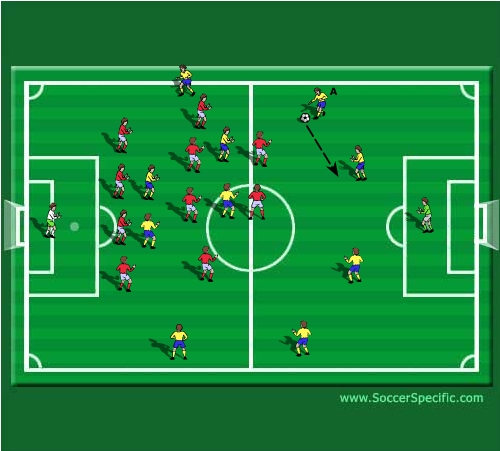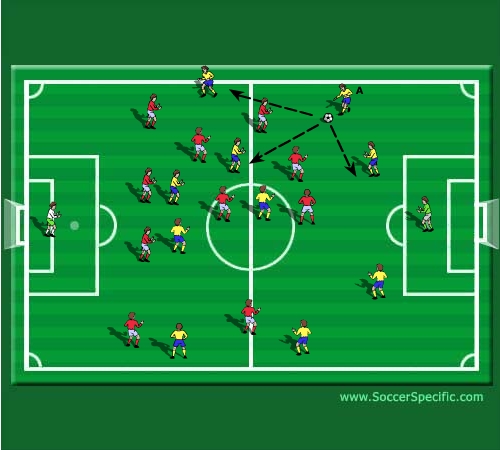Some confusion exists when the topic of low pressure defending arises. It does not mean that a team allows their opponent to stroll around the field enjoying the freedom of time and space. Low pressure defending simply refers to the practice of retreating to a particular area of the field where the team decides to hold its line and meet the opposition. In contrast, high pressure defending simply means that the line is held higher up the field. While playing a low pressure style the team may retreat to the halfway line allowing their opponents the freedom to maintain possession in their own half. However, when the opposition attempts to penetrate, either with or without the ball, high intensity and high pressure defending ensues. Diagram (a) illustrates the red team opting to draw up their defensive pressure at the half-way line. As can be seen from the diagram the yellow team are allowed the freedom to maintain possession of the bvall in their own half of the field.
Some of the advantages of low pressure defending include: (1) limiting the space directly in front of goal in which the opponents can penetrate, (2) increased numbers behind the ball, (3) limited space in behind the back line that the opposition can exploit, (4) forcing the opponent to play in certain areas of the field, (5) can create the optimal environment for counterattacking.

In contrast, Diagram (b) below shows the red team losing their concentrated defensive posture. The result is that the yellow team has greater opportunity to penetrate.

As with any other tactical decision, certain considerations must be examined prior to adopting a low pressure style of play. These include:
Own teams technical, tactical and physical attributes – many times the inferior team will retreat to their own half of the field to try to maintain a sound defensive shape without allowing the opposition to play balls in behind their defense. This is not to say that only inferior teams will retreat, sit-in and defend. Even high level, extremely talented teams opt to retreat, sit-in and confine the space before hitting teams on the counter attack (see counter attack). These teams may have very mobile midfielders and forwards who can spring forward creating a devastating attack.
Temperature, humidity, elevation etc. – since low pressure defending can help preserve energy resources, many teams find success with adopting a low-pressure style when they are dealing with adverse climactic conditions (hot, humid). The same applies to teams playing at altitude. It must be restated that low pressure does not mean low intensity, and allowing the opponent to maintain possession for long periods can drain the defensive teams players both physically and mentally.
Time in game, score, importance of game – teams that are trying to protect a lead with little time remaining may opt to sit-in, concentrate their players in their own half in order to see out the remainder of the game. In “big” games teams may adopt a low-pressure style to be a little more conservative for fear of losing.
Home Vs. Away – many teams that play in a home and away format will opt to play more conservatively (low pressure) on the road, yet at home will high pressure and press (see pressing) their opponents.
